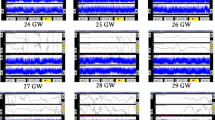Abstract
Background
With the improvement of perinatal care and neonatal intensive care technology in recent years, a preterm infant, especially with small gestational age and very low birth weight, survives more and more. At the same time, adverse neurodevelopmental prognosis caused by brain damage in preterm infant also increased significantly. Preterm infant brain injury has become the most important factor for early death and neurodevelopment of preterm infant.
Methods
Amplitude integration electroencephalogram (aEEG) has an important clinical value in the assessment of brain development in the maturity of preterm infant. With the application of a neonatal brain function monitor, we value the aEEG graphic continuity, periodicity, narrowband lower margin amplitude, and bandwidth score and analyze wide- and narrowband on the lower bounds of voltage and bandwidth.
Results
The graphics of preterm infant aEEG become mature with the growth of the gestational age (1). With the growth of corrected gestational age, the aEEG graphics of preterm infant has the following feature: lower bound voltage of narrowband rising and width narrowing of narrowband (2). Extrauterine life can speed up the maturation of aEEG graphics (3).
Conclusions
The aEEG technology is a noninvasive, operable, and simple analysis and suitable for application in the newborn intensive care unit.



Similar content being viewed by others
References
Inder TE, Tao J, Neil JJ (2011) Common lesions in the newborn brain. Top Magn Reson Imaging 22:25
Deuber C, Terhaar M (2011) Hyperoxia in very preterm infants: a systematic review of the literature. J Perinatal Neonatal Nurs 25:268
Vasiljevic B, Maglajlic-Djukic S, Gojnic M, Stankovic S, Ignjatovic S, Lutovac D (2011) New insights into the pathogenesis of perinatal hypoxic-ischemic brain injury. Pediatr Int 53:454–462
ter Horst HJ, Verhagen EA, Keating P, Bos AF (2011) The relationship between electrocerebral activity and cerebral fractional tissue oxygen extraction in preterm infants. Pediatr Res 70:384–388
Hellström-Westas L (2006) Continuous electroencephalography monitoring of the preterm infant. Clin Perinatol 33:633
Niemarkt HJ, Jennekens W, Maartens IA, Wassenberg T, van Aken M, Katgert T, Kramer BW, Gavilanes AWD, Zimmermann LJ, Bambang Oetomo S (2011) Multi-channel amplitude-integrated EEG characteristics in preterm infants with a normal neurodevelopment at two years of corrected age. Early Hum Dev 88(4):209–216
Wusthoff C, Shellhaas R, Clancy R (2008) Limitations of single-channel EEG on the forehead for neonatal seizure detection. J Perinatol 29:237–242
Sisman J, Campbell DE, Brion LP (2005) Amplitude-integrated EEG in preterm infants: maturation of background pattern and amplitude voltage with postmenstrual age and gestational age. J Perinatol 25:391–396
Burdjalov VF, Baumgart S, Spitzer AR (2003) Cerebral function monitoring: a new scoring system for the evaluation of brain maturation in neonates. Pediatrics 112:855–861
Olischar M, Klebermass K, Kuhle S, Hulek M, Kohlhauser C, Rücklinger E, Pollak A, Weninger M (2004) Reference values for amplitude-integrated electroencephalographic activity in preterm infants younger than 30 weeks' gestational age. Pediatrics 113:e61–e66
Zhang D, Liu Y, Hou X, Zhou C, Luo Y, Ye D, Ding H (2011) Reference values for amplitude-integrated EEGS in infants from preterm to 3.5 months of age. Pediatrics 127:e1280–e1287
Shi Y, Cheng G, Shao X, Zhuang D, Liu D, Liu X, Wang J, Yao M, Wang Z, Zhou W (2011) Amplitude integrated electroencephalography characteristics of normal preterm newborns: a multicenter clinical study. Zhonghua Er Ke Za Zhi (Chin J Pediatr) 49:648
Toet MC, van der Meij W, de Vries LS, Uiterwaal CSPM, van Huffelen KC (2002) Comparison between simultaneously recorded amplitude integrated electroencephalogram (cerebral function monitor) and standard electroencephalogram in neonates. Pediatrics 109:772–779
Shellhaas RA, Gallagher PR, Clancy RR (2008) Assessment of neonatal electroencephalography (EEG) background by conventional and two amplitude-integrated EEG classification systems. J Pediatr 153:369–374
Scher MS, Johnson MW, Holditch-Davis D (2005) Cyclicity of neonatal sleep behaviors at 25 to 30 weeks' postconceptional age. Pediatr Res 57:879–882
Kuint J, Turgeman A, Torjman A, Maayan-Metzger A (2007) Characteristics of amplitude-integrated electroencephalogram in premature infants. J Child Neurol 22:277–281
Hellström-Westas L, Rosen I, De Vries L, Greisen G (2006) Amplitude-integrated EEG classification and interpretation in preterm and term infants. NeoReviews 7:e76–e87
Klebermass K, Olischar M, Waldhoer T, Fuiko R, Pollak A, Weninger M (2011) Amplitude-integrated EEG pattern predicts further outcome in preterm infants. Pediatr Res 70:102–108
Soubasi V, Mitsakis K, Nakas CT, Petridou S, Sarafidis K, Griva M, Agakidou E, Drossou V (2009) The influence of extrauterine life on the aEEG maturation in normal preterm infants. Early Hum Dev 85:761–765
Foreman SW, Thorngate L, Burr RL, Thomas KA (2011) Electrode challenges in amplitude-integrated electroencephalography (aEEG): research application of a novel noninvasive measure of brain function in preterm infants. Biol Res Nurs 13:251–259
Fanaro S (2010) Which is the ideal target for preterm growth? Minerva pediatr 62:77
Allen MC (2005) Assessment of gestational age and neuromaturation. Ment Retard Dev Disabil Res Rev 11:21–33
Wikström S, Pupp IH, Rosén I, Norman E, Fellman V, Ley D, Hellström-Westas L (2012) Early single-channel aEEG/EEG predicts outcome in very preterm infants. Acta Paediatrica 101(7):719–726
Funding
This study was supported by the National Natural Science Foundation of China, No. 81241022 and the Natural Science Foundation of Beijing, No. 7122045.
Author information
Authors and Affiliations
Corresponding author
Rights and permissions
About this article
Cite this article
Cui, H., Ding, Y., Yu, Y. et al. Changes of amplitude integration electroencephalogram (aEEG) in different maturity preterm infant. Childs Nerv Syst 29, 1169–1176 (2013). https://doi.org/10.1007/s00381-013-2060-5
Received:
Accepted:
Published:
Issue Date:
DOI: https://doi.org/10.1007/s00381-013-2060-5




